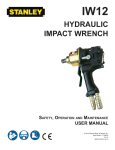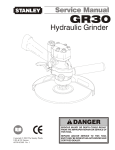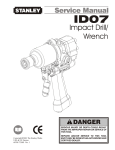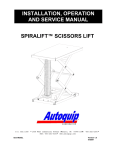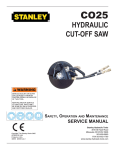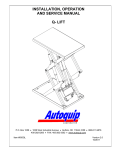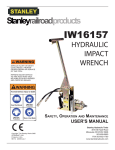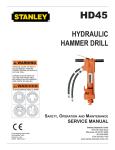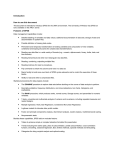Download IW12 Service Manual.indb
Transcript
IW12 HYDRAULIC IMPACT WRENCH WARNING To avoid serious injury or death Read the Manual Wear Eye Protection Wear Ear Protection Wear Dust Mask SAFETY, OPERATION AND MAINTENANCE 47351 Copyright© The Stanley Works 2005 OPS/SVCE USA Printed in U.S.A. 08074 3/2005 ver 2 SERVICE MANUAL Stanley Hydraulic Tools 3810 SE Naef Road Milwaukie OR 97267-5698 503-659-5660 FAX 503-652-1780 www.stanley-hydraulic-tools.com TABLE OF CONTENTS SAFETY SYMBOLS....................................................................................................................................................................... 5 SAFETY PRECAUTIONS .............................................................................................................................................................. 6 TOOL STICKERS & TAGS ............................................................................................................................................................ 7 HYDRAULIC HOSE REQUIREMENTS ......................................................................................................................................... 8 HOSE TYPES ................................................................................................................................................................................ 8 HOSE SAFETY TAGS ................................................................................................................................................................... 8 HOSE PRESSURE RATING.......................................................................................................................................................... 8 HTMA REQUIREMENTS ............................................................................................................................................................... 9 OPERATION ................................................................................................................................................................................ 10 EQUIPMENT PROTECTION & CARE......................................................................................................................................... 12 TROUBLESHOOTING ................................................................................................................................................................. 13 SPECIFICATIONS ....................................................................................................................................................................... 14 ACCESSORIES ........................................................................................................................................................................... 14 SERVICE ..................................................................................................................................................................................... 15 PRIOR TO DISASSEMBLY .................................................................................................................................................... 15 IMPACT MECHANISM REMOVAL, CLEANING & INSTALLATION ....................................................................................... 15 REMOVAL .............................................................................................................................................................................. 15 INSTALLATION ...................................................................................................................................................................... 15 WRENCH DISASSEMBLY & REASSEMBLY FOR REPAIR .................................................................................................. 16 MOTOR DISASSEMBLY ........................................................................................................................................................ 16 MOTOR CLEANING & INSPECTION .................................................................................................................................... 16 CLEANING ............................................................................................................................................................................. 16 BUSHINGS (MAIN HOUSING & MOTOR CAP) .................................................................................................................... 16 GEAR CHAMBER (MOTOR CAP) ......................................................................................................................................... 16 GEARS ................................................................................................................................................................................... 16 MAIN HOUSING ASSEMBLY ................................................................................................................................................. 16 SHAFTS ................................................................................................................................................................................. 16 MAIN HOUSING DISASSEMBLY........................................................................................................................................... 16 PRIOR TO REASSEMBLY ..................................................................................................................................................... 17 MAIN HOUSING ASSEMBLY ................................................................................................................................................. 17 MOTOR ASSEMBLY .............................................................................................................................................................. 17 IMPACT INTENSITY ADJUSTMENT...................................................................................................................................... 18 ADJUSTMENT ....................................................................................................................................................................... 18 STANDARD IMPACT MECHANISM MODEL ......................................................................................................................... 19 IW12 PARTS LIST ....................................................................................................................................................................... 20 HEAVY DUTY IMPACT MECHANISM MODEL ........................................................................................................................... 21 IW12 PARTS LIST ....................................................................................................................................................................... 22 WARRANTY................................................................................................................................................................................. 23 SERVICING THE STANLEY HYDRAULIC IMPACT WRENCH: This manual contains safety, operation, and routine maintenance instructions. Servicing of hydraulic tools, other than routine maintenance, must be performed by an authorized and certified dealer. Please read the following warning. WARNING SERIOUS INJURY OR DEATH COULD RESULT FROM THE IMPROPER REPAIR OR SERVICE OF THIS TOOL. REPAIRS AND / OR SERVICE TO THIS TOOL MUST ONLY BE DONE BY AN AUTHORIZED AND CERTIFIED DEALER. For the nearest authorized and certified dealer, call Stanley Hydraulic Tools at the number listed on the back of this manual and ask for a Customer Service Representative. 3 CERTIFICATE OF CONFORMITY ÜBEREINSTIMMUNGS-ZERTIFIKAT CERTIFICAT DE CONFORMITE CEE CERTIFICADO DE CONFORMIDAD CERTIFICATO DI CONFORMITA Hydraulic Tools Hydraulic Tools ______________________________________________________________________ I, the undersigned: Ich, der Unterzeichnende: Je soussigné: El abajo firmante: lo sottoscritto: Burrows, James Surname and First names/Familiennname und Vemamen/Nom et prénoms/Nombre y apellido/Cognome e nome hereby certify that the construction plant or equipment specified hereunder: bestätigt hiermit, daß die Konstruktion und Ausrüstung wie folgt spezifiziert ist: certifies par ceci que í usine ou í équipement de construction a indiqué cidessous: por el presente certifico que la fabrica o el equipo especificado a continuacion: certifico che l’impianto o l’attrezzatura sotto specificata: 1. Category: Kategorie: Catégorie: Categoria: Categoria: 2. Make/Ausführung/Marque/Marca/Fabbricazione 3. Type/Typ/Type/Tipo/Tipo: 4. Type serial number of equipment: Typ und Serien - Nr. der Ausrüstung: Numéro dans la série du type de matériel: Numero de serie tipo del equipo: Matricola dell´attrezzatura: 5. Impact Wrench Stanley IW1214001, IW1234001 All Year of manufacture/Baujahr/année de fabrication/Año de fabricacion/Anno di fabbricazione 2004 has been manufactured in conformity with - EEC Type examination as shown. wurde hergestellt in Übereinstimmung mit - EEC Typ-Prüfung nach. est fabriqué conformément - au(x) type(s) examiné(s) comme indiqué dans le tableau ci-après. ha sido fabricado de acuerdo con - tipo examen EEC como dice. è stata costruita in conformitá con - le norme CEE come illustrato. Examen CEE de type Directive Richtlinie Directives particulières Directriz Direttiva No. Nr Numéro No n. Date Datum Date Fecha Data Approved body Prüfung durch Organisme agréé Aprobado Collaudato Date of expiry Ablauf datum Date d´expiration Fecha de caducidad Data di scadenza EN EN ISO EN Machinery Directive 792-6 3744 28662-7 98/37/EC 1994 1995 1997 1998 Self Self Self Self NA NA NA NA 6. Special Provisions: None Spezielle Bestimmungen: Dispositions particulières: Provisiones especiales: Misure special: Done at/Ort/Fait à/Dado en/Fatto a Stanley Hydraulic Tools, Milwaukie, Oregon USA Date/Datum/le/Fecha/Data 6/08/04 Signature/Unterschrift/Signature/Firma/Firma Position/Position/Fonction/Puesto/Posizione Engineering Manager Rev01 6/04 4 SAFETY SYMBOLS Safety symbols and signal words, as shown below, are used to emphasize all operator, maintenance and repair actions which, if not strictly followed, could result in a life-threatening situation, bodily injury or damage to equipment. This is the safety alert symbol. It is used to alert you to potential personal injury hazards. Obey all safety messages that follow this symbol to avoid possible injury or death. DANGER This safety alert and signal word indicate an imminently hazardous situation which, if not avoided, will result in death or serious injury. WARNING This safety alert and signal word indicate a potentially hazardous situation which, if not avoided, could result in death or serious injury. CAUTION This safety alert and signal word indicate a potentially hazardous situation which, if not avoided, may result in minor or moderate injury. This signal word indicates a potentially hazardous situation which, if not avoided, may result in property damage. NOTICE This signal word indicates a situation which, if not avoided, will result in damage to the equipment. IMPORTANT This signal word indicates a situation which, if not avoided, may result in damage to the equipment. Always observe safety symbols. They are included for your safety and for the protection of the tool. LOCAL SAFETY REGULATIONS Enter any local safety regulations here. Keep these instructions in an area accessible to the operator and maintenance personnel. 5 SAFETY PRECAUTIONS Tool operators and maintenance personnel must always comply with the safety precautions given in this manual and on the stickers and tags attached to the tool and hose. These safety precautions are given for your safety. Review them carefully before operating the tool and before performing general maintenance or repairs. To avoid serious injury or death Supervising personnel should develop additional precautions relating to the specific work area and local safety regulations. If so, place the added precautions in the space provided on page 5. Read the Manual Wear Ear Protection Wear Eye Protection The model IW12 Hydraulic Impact Wrench will provide safe and dependable service if operated in accordance with the instructions given in this manual. Read and understand this manual and any stickers and tags attached to the tool and hose before operation. Failure to do so could result in personal injury or equipment damage. Wear Dust Mask 47351 • The operator must start in a work area without bystanders. Flying debris can cause serious injury. • Do not operate the tool unless thoroughly trained or under the supervision of an instructor. Establish a training program for all operators to ensure safe operation. • Always wear safety equipment such as goggles, ear and head protection, and safety shoes at all times when operating the tool. Use gloves and aprons when necessary. • The operator must be familiar with all prohibited work areas such as excessive slopes and dangerous terrain conditions. • Maintain proper footing and balance at all times. • Do not inspect or clean the tool while the hydraulic power source is connected. Accidental engagement of the tool can cause serious injury. • Always connect hoses to the tool hose couplers before energizing the hydraulic power source. Be sure all hose connections are tight and are in good condition. • Do not operate the tool at oil temperatures above 140°F/60°C. Operation at higher temperatures can cause higher than normal temperatures at the tool which can result in operator discomfort. • Do not operate a damaged, improperly adjusted, or incompletely assembled impact wrench. • Never wear loose clothing that can get entangled in the working parts of the tool. • Keep all parts of your body away from the rotating parts. Long hair or loose clothing can become drawn into rotating components. • Always use accessories that conform to the specifications given in the OPERATION section of this manual. • Do not reverse impact wrench rotation direction by changing fluid flow direction. • Release the trigger if the power supply has been interrupted. • When working near electrical conductors, always assume that all conductors are energized and that insulation, clothing and hoses can conduct electricity. Use hose labeled and certified as non-conductive. • To avoid personal injury or equipment damage, all tool repair, maintenance and service must only be performed by authorized and properly trained personnel. 6 TOOL STICKERS & TAGS DANGER Failure to use hydraulic hose labeled and certified L as non-conductive when using hydraulic tools on or near electric lines may result in death or serious injury. For proper and safe operation read owners manual 25610 RAILROAD HELP DESK DECAL and mwke sure that you have been properly ELECTROCUTION HAZARD trained in correct procedures required for work on or around electric lines. 29083 ROTATION DIRECTION DECAL 12412 DANGER DECAL WA 108 28788 MANUAL DECAL (CE) 29530 SOUND POWER LEVEL DECAL (CE) 4-12 GPM / 15-45 LPM DO NOT EXCEED 2000 PSI / 140 BAR 28322 CE DECAL (CE) DO NOT EXCEED SPECIFIED FLOW OR PRESSURE USE CLOSED-CENTER TOOL ON CLOSED-CENTER SYSTEM. USE OPEN-CENTER TOOL ON OPEN-CENTER SYSTEM. CORRECTLY CONNECT HOSES TO TOOL “IN” AND “OUT” PORTS. IMPROPER HANDLING, USE OR OTHER MAINTENANCE OF TOOL COULD RESULT IN A LEAK, BURST OR OTHER TOOL FAILURE. CONTACT AT A LEAK OR BURST CAN CAUSE OIL INJECTION INTO THE BODY. FAILURE TO OBSERVE THESE PRECAUTIONS CAN RESULT IN SERIOUS PERSONAL INJURY. D 30 LPM @ 138 B AR EHTMA CATEGORY 03788 GPM DECAL 11207 CIRCUIT TYPE D DECAL (CE) Stanley Hydraulic Tools 3810 SE Naef Road Milwaukie, Oregon USA 4-12 GPM / 15-45 LPM DO NOT EXCEED 2000 PSI/140 BAR Model No. IW12 DO NOT EXCEED SPECIFIED FLOW OR PRESSURE. • USE CLOSED-CENTER TOOL ON CLOSED-CENTER SYSTEM. • USE OPEN-CENTER TOOL ON OPEN-CENTER SYSTEM. • CORRECTLY CONNECT HOSE TO TOOL “IN” AND “OUT” PORTS. IMPROPER HANDLING USE OR MAINTENANCE OF TOOL COULD RESULT IN A LEAK, BURST OR OTHER TOOL FAILURE. • CONTACT AT A LEAK OR BURST CAN CAUSE OIL INJECTIONS INTO THE BODY. • FAILURE TO OBSERVE THESE PRECAUTIONS CAN RESULT IN SERIOUS PERSONAL INJURY. 08012 IW12 NAME TAG (US & CE) 17275 GPM/PRESSURE DANGER DECAL D A N G E R NOTE THE INFORMATION LISTED ON THE STICKERS SHOWN, MUST BE LEGIBLE AT ALL TIMES. REPLACE DECALS IF THEY BECOME WORN OR DAMAGED. REPLACEMENTS ARE AVAILABLE FROM YOUR LOCAL STANLEY DISTRIBUTOR. The safety tag (p/n 15875) at right is attached to the tool when shipped from the factory. Read and understand the safety instructions listed on this tag before removal. We suggest you retain this tag and attach it to the tool when not in use. 15-45 LPM / 4-12 GPM 140 BAR / 2000 PSI 1. FAILURE TO USE HYDRAULIC HOSE LABELED AND CERTIFIED AS NON-CONDUCTIVE WHEN USING HYDRAULIC TOOLS ON OR NEAR ELECTRICAL LINES MAY RESULT IN DEATH OR SERIOUS INJURY. BEFORE USING HOSE LABELED AND CERTIFIED AS NONCONDUCTIVE ON OR NEAR ELECTRIC LINES BE SURE THE HOSE IS MAINTAINED AS NON-CONDUCTIVE. THE HOSE SHOULD BE REGULARLY TESTED FOR ELECTRIC CURRENT LEAKAGE IN ACCORDANCE WITH YOUR SAFETY DEPARTMENT INSTRUCTIONS. 2. A HYDRAULIC LEAK OR BURST MAY CAUSE OIL INJECTION INTO THE BODY OR CAUSE OTHER SEVERE PERSONAL INJURY. A DO NOT EXCEED SPECIFIED FLOW AND PRESSURE FOR THIS TOOL. EXCESS FLOW OR PRESSURE MAY CAUSE A LEAK OR BURST. B DO NOT EXCEED RATED WORKING PRESSURE OF HYDRAU LIC HOSE USED WITH THIS TOOL. EXCESS PRESSURE MAY CAUSE A LEAK OR BURST. C CHECK TOOL HOSE COUPLERS AND CONNECTORS DAILY FOR LEAKS. DO NOT FEEL FOR LEAKS WITH YOUR D A N G E R D DO NOT LIFT OR CARRY TOOL BY THE HOSES. DO NOT ABUSE HOSE. DO NOT USE KINKED, TORN OR DAMAGED HOSE. 3. MAKE SURE HYDRAULIC HOSES ARE PROPERLY CONNECTED TO THE TOOL BEFORE PRESSURING SYSTEM. SYSTEM PRESSURE HOSE MUST ALWAYS BE CONNECTED TO TOOL “IN” PORT. SYSTEM RETURN HOSE MUST ALWAYS BE CONNECTED TO TOOL “OUT” PORT. REVERSING CONNECTIONS MAY CAUSE REVERSE TOOL OPERATION WHICH CAN RESULT IN SEVERE PERSONAL INJURY. 4. DO NOT CONNECT OPEN-CENTER TOOLS TO CLOSED-CENTER HYDRAULIC SYSTEMS. THIS MAY RESULT IN LOSS OF OTHER HYDRAULIC FUNCTIONS POWERED BY THE SAME SYSTEM AND/OR SEVERE PERSONAL INJURY. 5. BYSTANDERS MAY BE INJURED IN YOUR WORK AREA. KEEP BYSTANDERS CLEAR OF YOUR WORK AREA. 6. WEAR HEARING, EYE, FOOT, HAND AND HEAD PROTECTION. 7. TO AVOID PERSONAL INJURY OR EQUIPMENT DAMAGE, ALL TOOL REPAIR MAINTENANCE AND SERVICE MUST ONLY BE PERFORMED BY AUTHORIZED AND PROPERLY TRAINED PERSONNEL. IMPORTANT IMPORTANT READ OPERATION MANUAL AND SAFETY INSTRUCTIONS FOR THIS TOOL BEFORE USING IT. READ OPERATION MANUAL AND SAFETY INSTRUCTIONS FOR THIS TOOL BEFORE USING IT. USE ONLY PARTS AND REPAIR PROCEDURES APPROVED BY STANLEY AND DESCRIBED IN THE OPERATION MANUAL. USE ONLY PARTS AND REPAIR PROCEDURES APPROVED BY STANLEY AND DESCRIBED IN THE OPERATION MANUAL. TAG TO BE REMOVED ONLY BY TOOL OPERATOR. TAG TO BE REMOVED ONLY BY TOOL OPERATOR. SEE OTHER SIDE SEE OTHER SIDE SAFETY TAG P/N 15875 7 (shown smaller then actual size) HYDRAULIC HOSE REQUIREMENTS HOSE TYPES Hydraulic hose types authorized for use with Stanley Hydraulic Tools are as follows: Certified non-conductive Wire-braided (conductive) Fabric-braided (not certified or labeled non-conductive) Hose listed above is the only hose authorized for use near electrical conductors. Hoses and listed above are conductive and must never be used near electrical conductors. HOSE SAFETY TAGS To help ensure your safety, the following DANGER tags are attached to all hose purchased from Stanley Hydraulic Tools. DO NOT REMOVE THESE TAGS. If the information on a tag is illegible because of wear or damage, replace the tag immediately. A new tag may be obtained from your Stanley Distributor. D A N G E R D A N G E R 1 FAILURE TO USE HYDRAULIC HOSE LABELED AND CERTIFIED AS NON-CONDUCTIVE WHEN USING HYDRAULIC TOOLS ON OR NEAR ELECTRIC LINES MAYRESULT IN DEATH OR SERIOUS INJURY. FOR PROPER AND SAFE OPERATION MAKE SURE THAT YOU HAVE BEEN PROPERLY TRAINED IN CORRECT PROCEDURES REQUIRED FOR WORK ON OR AROUND ELECTRIC LINES. 3. DO NOT EXCEED HOSE WORKING PRESSURE OR ABUSE HOSE. IMPROPER USE OR HANDLING OF HOSE COULD RESULT IN BURST OR OTHER HOSE FAILURE. KEEP HOSE AS FAR AWAY AS POSSIBLE FROM BODY AND DO NOT PERMIT DIRECT CONTACT DURING USE. CONTACT AT THE BURST CAN CAUSE BODILY INJECTION AND SEVERE PERSONAL INJURY. 4. HANDLE AND ROUTE HOSE CAREFULLY TO AVOID KINKING, ABRASION, CUTTING, OR CONTACT WITH HIGH TEMPERATURE SURFACES. DO NOT USE IF KINKED. DO NOT USE HOSE TO PULL OR LIFT TOOLS, POWER UNITS, ETC. 2. BEFORE USING HYDRAULIC HOSE LABELED AND CERTIFIED AS NON-CONDUCTIVE ON OR NEAR ELECTRIC LINES. WIPE THE ENTIRE LENGTH OF THE HOSE AND FITTING WITH A CLEAN DRY ABSORBENT CLOTH TO REMOVE DIRT AND MOSISTURE AND TEST HOSE FOR MAXIMUM ALLOWABLE CURRENT LEAKAGE IN ACCORDANCE WITH SAFETY DEPARTMENT INSTRUCTIONS. 5. CHECK ENTIRE HOSE FOR CUTS CRACKS LEAKS ABRASIONS, BULGES, OR DAMAGE TO COUPLINGS IF ANY OF THESE CONDITIONS EXIST, REPLACE THE HOSE IMMEDIATELY. NEVER USE TAPE OR ANY DEVICE TO ATTEMPT TO MEND THE HOSE. 6. AFTER EACH USE STORE IN A CLEAN DRY AREA. SIDE 1 3 DO NOT REMOVE THIS TAG DO NOT REMOVE THIS TAG THE TAG SHOWN BELOW IS ATTACHED TO “CERTIFIED NON-CONDUCTIVE” HOSE SIDE 2 (shown smaller than actual size) D A N G E R D A N G E R 1 DO NOT USE THIS HYDRAULIC HOSE ON OR NEAR ELECTRIC LINES. THIS HOSE IS NOT LABELED OR CERTIFIED AS NON-CONDUCTIVE. USING THIS HOSE ON OR NEAR ELECTRICAL LINES MAY RESULT IN DEATH OR SERIOUS INJURY. 5. CHECK ENTIRE HOSE FOR CUTS CRACKS LEAKS ABRASIONS, BULGES, OR DAMAGE TO COUPLINGS IF ANY OF THESE CONDITIONS EXIST, REPLACE THE HOSE IMMEDIATELY. NEVER USE TAPE OR ANY DEVICE TO ATTEMPT TO MEND THE HOSE. 2. FOR PROPER AND SAFE OPERATION MAKE SURE THAT YOU HAVE BEEN PROPERLY TRAINED IN CORRECT PROCEDURES REQUIRED FOR WORK ON OR AROUND ELECTRIC LINES. 6. AFTER EACH USE STORE IN A CLEAN DRY AREA. 3. DO NOT EXCEED HOSE WORKING PRESSURE OR ABUSE HOSE. IMPROPER USE OR HANDLING OF HOSE COULD RESULT IN BURST OR OTHER HOSE FAILURE. KEEP HOSE AS FAR AWAY AS POSSIBLE FROM BODY AND DO NOT PERMIT DIRECT CONTACT DURING USE. CONTACT AT THE BURST CAN CAUSE BODILY INJECTION AND SEVERE PERSONAL INJURY. 4. HANDLE AND ROUTE HOSE CAREFULLY TO AVOID KINKING, CUTTING, OR CONTACT WITH HIGH TEMPERATURE SURFACES. DO NOT USE IF KINKED. DO NOT USE HOSE TO PULL OR LIFT TOOLS, POWER UNITS, ETC. DO NOT REMOVE THIS TAG DO NOT REMOVE THIS TAG THE TAG SHOWN BELOW IS ATTACHED TO “CONDUCTIVE” HOSE. SEE OTHER SIDE SIDE 1 SIDE 2 (shown smaller than actual size) HOSE PRESSURE RATING The rated working pressure of the hydraulic hose must be equal to or higher than the relief valve setting on the hydraulic system. 8 HTMA REQUIREMENTS TOOL CATEGORY HYDRAULIC SYSTEM REQUIREMENTS FLOW RATE TYPE 1 TYPEII 7-9 gpm (26-34 lpm) 2000 psi (138 bar) TYPEIII TOOL OPERATING PRESSURE (at the power supply outlet) 4-6 gpm (15-23 lpm) 2000 psi (138 bar) SYSTEM RELIEF VALVE SETTING (at the power supply outlet) 2100-2250 psi 2100-2250 psi 2100-2250 psi 2200-2300 psi (145-155 bar) (145-155 bar) (145-155 bar) (152-159 bar) MAXIMUM BACK PRESSURE (at tool end of the return hose) 250 psi (17 bar) Measured at a max. fluid viscosity of: (at min. operating temperature) 400 ssu* 400 ssu* 400 ssu* 400 ssu* (82 centistokes) (82 centistokes) (82 centistokes) (82 centistokes) TEMPERATURE Sufficient heat rejection capacity to limit max. fluid temperature to: (at max. expected ambient temperature) 140° F (60° C) 140° F (60° C) 140° F (60° C) 140° F (60° C) Min. cooling capacity at a temperature difference of between ambient and fluid temps 3 hp (2.24 kW) 40° F (22° C) 5 hp (3.73 kW) 40° F (22° C) 7 hp (4.47 kW) 40° F (22° C) 6 hp (5.22 kW) 40° F (22° C) 250 psi (17 bar) 11-13 gpm (42-49 lpm) 2000 psi (138 bar) TYPE RR 250 psi (17 bar) 9-10.5 gpm (34-40 lpm) 2000 psi (138 bar) 250 psi (17 bar) NOTE: Do not operate the tool at oil temperatures above 140° F (60° C). Operation at higher temperatures can cause operator discomfort at the tool. FILTER 25 microns Min. full-flow filtration 30 gpm Sized for flow of at least: (114 lpm) (For cold temp. startup and max. dirt-holding capacity) 25 microns 30 gpm (114 lpm) HYDRAULIC FLUID Petroleum based (premium grade, anti-wear, non-conductive) VISCOSITY (at min. and max. operating temps) 100-400 ssu* 100-400 ssu* (20-82 centistokes) 100-400 ssu* 25 microns 30 gpm (114 lpm) 25 microns 30 gpm (114 lpm) 100-400 ssu* NOTE: When choosing hydraulic fluid, the expected oil temperature extremes that will be experienced in service determine the most suitable temperature viscosity characteristics. Hydraulic fluids with a viscosity index over 140 will meet the requirements over a wide range of operating temperatures. *SSU = Saybolt Seconds Universal NOTE: These are general hydraulic system requirements. See tool Specification page for tool specific requirements. 9 OPERATION WRENCH TORQUE INFORMATION FACTORS THAT AFFECT TORQUE An impact wrench is a rotary hammer that impacts the head of a bolt or nut. It does not apply a slow steady torque as a standard torque wrench. Therefore, several factors affect the result of torque when using impact wrenches: 1. LONG BOLTS. Long bolts having high-friction threads with lubrication under the bolt head or associated nut can twist when impacted, then untwist before the next impact. This will especially happen if there is low friction between the bolt head or nut and the mating surface. 2. HEAVY, LOOSE OR MULTIPLE ADAPTERS. Heavy, loose or multiple adapters between the wrench and socket can dissipate the intensity of the impact to the bolt head or nut. 3. AMOUNT OF IMPACT. Maximum torque results can be obtained by allowing continuous impacting of the socket against the bolt head or nut for at least 10 seconds. 4. HYDRAULIC FLOW RATE. If the flow rate to the tool is too low, the hammer (or impact) speed is reduced. If the flow is correct, a change in the relief pressure does not affect the impact force. Poorly designed hydraulic circuits can result in lower flow rates and reduced impact speeds when pressure is required during impacting. 2. Make certain that the hydraulic power source is equipped with a relief valve set to open at 2100 psi/145 bar minimum. CONNECT HOSES 1. Wipe all hose couplers with a clean, lint-free cloth before making connections. 2. Connect hoses from the hydraulic power source to the tool fittings or quick disconnects. It is good practice to connect the return hose first and disconnect it last to minimize or eliminate trapped pressure within the wrench. 3. Observe the flow indicators stamped on the main body assembly and the hose couplers to ensure that the flow is in the proper directions. The female couple on the tools “IN” port is the inlet (pressure) coupler. Note: If the uncoupled hoses are left in the sun, pressure increase within the hoses can make them difficult to connect. Whenever possible, connect the free ends of hoses together. WRENCH OPERATION The IW12 is designed for 3/4-inch square sockets and accessories. Adapter part number 06790 or equivalent will permit the use of 5/8-inch quick change drive attachments. BOLT GRADE AND THREAD RECOMMENDATIONS Normal applications include installation or removal of fasteners requiring torque in the range of 300-1200 ft lb/4071627 Nm and auger bit wood boring. DO NOT use the wrench as a hammer drill for metal drilling. Allowable bolt torque is limited by both bolt thread diameter and grade of steel in the bolt. The IW12 Impact Wrench is recommended for use on the following bolt grade and thread sizes: During normal operation it is common to see some grease leakage from around the anvil during hard use. Refer to the IW12 Service Manual for the correct lubrication procedures. SAE Grade 2 SAE Grade 5 SAE Grade 8 1 to 1-1/2 inch / 25/38 mm 3/4 to 1-1/4 inch / 19-32 mm 5/8 to 1 inch / 16-25 mm 1. Observe all Safety Precautions. 2. Move the hydraulic circuit control valve to the “ON” position to operate the wrench. PREOPERATION PROCEDURES WARNING CHECK POWER SOURCE Always use sockets and accessories designed for impact type applications. DO NOT USE STANDARD SOCKETS OR ACCESSORIES. THESE CAN CRACK OR FRACTURE DURING OPERATION. 1. Using a calibrated flow meter and pressure gauge, check that the hydraulic power source develops a flow of 4-12 gpm/15-45 lpm at 1000-2000 psi/70-140 bar. 10 OPERATION 3. Select the direction of impact desired using the rotary reversing valve located on the left side of the wrench. To select clockwise direction, move the lever toward the front (drive end) of the wrench. To select counterclockwise direction, move the lever to the rear (handle end) of the wrench. Note: To more accurately tighten bolts, lubricate threads, check with a torque wrench and duplicate time of impacting for other bolts of the same length and thread size. 4. Squeeze the trigger to activate the wrench. 5. Release the trigger to stop the wrench. COLD WEATHER OPERATION If the wrench is to be used during cold weather, preheat the hydraulic fluid at low engine speed. When using the normally recommended fluids, fluid temperature should be at or above 50o F/10o C (400 ssu/82 centistokes) before use. Damage to the hydraulic system or wrench can result from use with fluid that is too viscous or too thick. POST OPERATION UNDERWATER MODELS ONLY The wrench impact mechanism must be cleaned and greased with waterproof grease after every day of use. The main housing valve and motor are sealed and do not require maintenance unless they are malfunctioning. Remove, clean, grease and assemble the impact mechanism as described in the IW12 Service Manual. 11 EQUIPMENT PROTECTION & CARE NOTICE In addition to the Safety Precautions in this manual, observe the following for equipment protection and care. • Make sure all couplers are wiped clean before connection. • The hydraulic circuit control valve must be in the “OFF” position when coupling or uncoupling hydraulic tools. Failure to do so may result in damage to the quick couplers and cause overheating of the hydraulic system. • Always store the tool in a clean dry space, safe from damage or pilferage. • Make sure the circuit PRESSURE hose (with male quick disconnect) is connected to the “IN” port. The circuit RETURN hose (with female quick disconnect) is connected to the opposite port. Do not reverse circuit flow. This can cause damage to internal seals. • Always replace hoses, couplings and other parts with replacement parts recommended by Stanley Hydraulic Tools. Supply hoses must have a minimum working pressure rating of 2500 psi/172 bar. • Do not exceed the rated flow (see Specifications) in this manual for correct flow rate and model number. Rapid failure of the internal seals may result. • Always keep critical tool markings, such as warning stickers and tags legible. • Tool repair should be performed by experienced personnel only. • Make certain that the recommended relief valves are installed in the pressure side of the system. • Do not use the tool for applications for which it was not intended. 12 TROUBLESHOOTING If symptoms of poor performance develop, the following chart can be used as a guide to correct the problem. When diagnosing faults in operation of the wrench, always check that the hydraulic power source is supplying the correct hydraulic flow and pressure to the tool as listed in the following table. Use a flow meter known to be accurate. Check the flow with the hydraulic fluid temperature at least 80o F/27o C. PROBLEM Low performance or impact. CAUSE SOLUTION Incorrect hydraulic flow. Check that the hydraulic power source is producing 4-12 gpm/15-45 lpm at 1000-2000 psi/70-140 bar. Defective quick disconnects. Check each quick disconnect. Worn impact mechanism. Repair or replace the impact mechanism. See Service Mechanism Removal Cleaning and Installation procedure to extend mechanism life. Hammer pins broken. Replace with integral frame (with pins). Check relief adjustment screw setting. Job may require a larger wrench. Incorrect grease or periodic maintenance of the impact mechanism is not being performed. See Service Instructions. Spools incorrectly installed. Valve(s) incorrectly reassembled. See Service Instructions. Sockets or adapters too heavy or loose. Use the correct impact type sockets or adapters. Long bolt with lubricated head. Lubricate threads only. Incorrect hydraulic flow (too high). Check that hydraulic power source is producing 4-12 gpm/15-45 lpm at 1000-2000 psi/70-140 bar. Supply and return hoses reversed. Install hoses correctly. Refer to Operation Instructions in this manual. Relief sleeve or spring damaged. Remove and replace spool assembly. Adjusting screw is in too far. Adjust correctly. Grease leaks at anvil busing, wrench warm. Hard duty cycle and heat forces grease out. Normal unless greasing instructions in Service Instructions are not followed. Grease leaks at anvil bushing, wrench cold. Main shaft O-ring leaking. Replace as required. Oil leak at motor cap face. Fasteners loose. Tighten to recommended torque. Face O-ring worn or missing. Replace as required. Wrench runs too fast. Impact mechanism or screws broken. Oil leaks at reversing spool. Motor cap/main housing damaged. Replace as required. Damaged O-rings. Replace as required. Check Service Instructions to avoid cutting O-rings on cross holes in the spool bore. Wrong hydraulic fluid. Circuit too hot. Refer to Operation Instructions for correct fluid/circuit specifications. 13 SPECIFICATIONS Drive Size ...............................................................................................3/4-inch Square Drive, 5/8-inch Hex Quick Change Weight ................................................................................................................................................................... 14 lbs/6 kg Overall Length ..............................................................................................................................................9-1/2-inch/24 cm Width ..................................................................................................................................................................4-inch/10 cm Pressure Range ............................................................................................................................ 1000-2000 psi/70-140 bar Flow Range ............................................................................................................................................ 4-12 gpm/15-45 lpm Optimum Flow ........................................................................................................................................ 5-10 gpm/20-38 lpm System Type ....................................................................................................Open and Closed Center, HTMA Type II or III Porting ..............................................................................................................................................................8 SAE O-Ring Output Speed (free spin) .............................................................................................................. 2000 rpm at 5 gpm/19 lpm Input Speed .....................................................................................................................................1200 Impacts per Minute Connect Size and Type ............................................................................................................... 3/8-inch Male Pipe Adapter Torque .......................................................................................................................................250-1200 ft. lb/340-1632 Nm Sound Power Level ....................................................................................................................................................108dBA Vibration Level .........................................................................................................................................................2.8 m/sec Sound Pressure Level @1m .....................................................................................................................................100 dBA ACCESSORIES DESCRIPTION PART NUMBER 3/4-inch Square Anvil to 3/4-inch Jacobs Chuck .......................................................................................................... 01857 7/16-inch Hex Shank x 1/2-inch Square Male Adapter ................................................................................................. 05117 5/8-inch Hex Shank x 1/2-inch Square Male Adapter ................................................................................................... 05080 3/4-inch Square Anvil to 5/8-inch Hex Quick Change Adapter ..................................................................................... 06790 Auger Drill Bits - Lineman’s Style 5/8-inch Hex Shank use with Hex Adapter 06790 5/8 Hex Pole Bit, 9/16 x 18 x 22 Overall Length ...........................................................................................................27845 5/8 Hex Pole Bit, 13/16 x 18 x 22 Overall Length .........................................................................................................27847 14 SERVICE Good maintenance practice keeps the wrench on the job and increases its service life. IMPACT MECHANISM REMOVAL, CLEANING & INSTALLATION The most important maintenance practice is to keep the hydraulic fluid clean at all times. Contaminated hydraulic fluid causes rapid wear and/or failure of internal parts. REMOVAL Follow the procedures contained in the Hydraulic System Requirements section of this manual to ensure peak performance from the tool. 1. Remove the four 3/8-16 x 1-3/4-inch/44 mm long socket head capscrews and lockwashers securing the hammer case assembly to the main body assembly. Never disassemble the main housing unless proper troubleshooting procedures have isolated the problem to an internal part. Then, disassemble the tool only to the extent necessary to replace the defective part. KEEP CONTAMINANTS SUCH AS DIRT AND GRIT AWAY FROM INTERNAL PARTS AT ALL TIMES. 2. On underwater models, loosen and remove the 10-24 x 1-3/4-inch/44 mm long socket head capscrew and locknut (or spirol pin) securing the lower end of the trigger guard to the main housing assembly and swing the trigger guard away. Always determine and correct the cause of the problem prior to reassembly. Further wear and tool failure can result if the original cause is not corrected. 3. Hold the wrench with the impact mechanism pointing down and depress the trigger while pulling the hammer case, gasket and impact mechanism away from the housing assembly. IMPORTANT 4. Remove the thrust bearing and two thrust races, if they were not removed with the impact mechanism. The impact mechanism is subject to grease “squeeze out”. Impact heat accumulation, centrifugal force throwing the grease away from moving parts and an expansion pressure pushing lubricant out the anvil bushing. Maintenance intervals vary with daily cycles, impact energy intensity and lubricant quality. It is very important that an inspection schedule be established to ensure that parts inside the mechanism are well lubricated. Be sure to remove any grease that appears to be burned. Make sure grease is packed around all parts. 5. Turn the hammer case (anvil up). The impact mechanism components will drop into your hand. 6. Remove the two hammer pins from the hammer frame. The hammer and anvil can be removed at this time. INSTALLATION 1. Thoroughly clean all parts of the mechanism. 2. Using the correct impact grease lubricate the inside of the hammer frame and install the hammer, anvil and two hammer pins. The inside of the hammer case should be free of grease to avoid over-lubrication. PRIOR TO DISASSEMBLY Clean the exterior of the tool. 3. Lubricate the hammer case bushing and slide onto the anvil. Obtain Impact Grease (part number 02718 for Land Models and Waterproof Impact Grease part number 03201 for Underwater Models). 4. Grease the thrust bearing and thrust races. Install the thrust race, thrust bearing and remaining thrust race on the main shaft in this order. Obtain Seal Kit part number 08073 or 13695 so all seals exposed during disassembly can be replaced during reassembly. 5. Install a new hammer case gasket (or O-ring). On underwater models, lubricate and install the O-ring in the hammer case bushing bore. Slide the hammer case assembly onto the anvil and secure with the four 3/8-16 x 1-3/4inch/44 mm long socket head capscrews and lockwashers. Tighten to a torque of 13-15 ft lb/17.6-20.3 Nm. 15 SERVICE GEAR CHAMBER (MOTOR CAP) 6. On underwater models, secure the lower trigger guard to the main housing using the 10-24 x 1-3/4-inch/44 mm long socket head capscrew and locknut. The gear chamber bores and end faces around the bores should be polished, not rough or grooved. The flat surfaces around the chamber and bolt holes should be flat and free of nicks and burrs that could cause misalignment or leaks. WRENCH DISASSEMBLY & REASSEMBLY FOR REPAIR GEARS MOTOR DISASSEMBLY Both gears should have flat, straight tips without nicks. They should have a smooth even polish on the teeth and end faces. Discard the gear if cracks are present. 1. Remove the impact mechanism as described in the Impact Mechanism Removal and Installation section of this manual. MAIN HOUSING ASSEMBLY 2. Remove the eight 3/8-16 x 1-3/4-inch/44 mm long socket head capscrews and lockwashers securing the motor cap assembly to the main housing. The gear running surfaces should show two inter-connecting polished circles without a step or roughness. IMPORTANT 3. With the wrench handle gripped in a vise, press on the splined end of the main shaft with one hand and support the motor cap assembly with the other. Press the motor cap assembly, gears and O-ring out of the main housing. DO NOT pry or in any way excessively force the motor cap assembly off of the main housing. If abnormal wear occurs in excess of normal polishing, both shafts and associated bushings must be replaced. The hydraulic system should be thoroughly flushed and the filter replaced before further operation of the wrench. 4. Remove the large O-ring from the motor cap assembly. 5. Remove the idler gear, idler shaft and main shaft. SHAFTS 6. If the relief adjustment screw O-ring requires replacement, loosen the jam nut and remove the relief adjustment screw. Be sure to count the number of turns required to remove it so it can be replaced in the same position. Refer to the Impact Adjustment section of this manual. The main diameter at the bushing locations must be smooth. Grooves, roughness or a reduced diameter indicates fluid contamination and damaged bushings. MAIN HOUSING DISASSEMBLY MOTOR CLEANING & INSPECTION Note: See the Parts List section of this manual for orientation of parts in the main housing assembly. CLEANING Clean all parts with a degreasing solvent. Blow dry with compressed air and wipe clean. Use only lint-free cloths. 1. Remove the 1/4-20 x 1/4-inch/6 mm long internal hex set screw securing the reversing spool lever and remove the lever from the reversing spool. BUSHINGS (MAIN HOUSING & MOTOR CAP) 2. Remove the retaining ring at the opposite end of the reversing spool. The inside of the bushings should be gray in color. If a significant amount of yellow-bronze shows, bushing replacement is required. Inspect shafts for corresponding wear and replace as required. 3. Pressing on the retaining ring end of the reversing spool, carefully slide the reversing spool in just far enough to gain access to the back-up ring and O-ring on the lever side. Remove the back-up ring with the appropriate O-ring tool. 4. Pressing on the lever end of the reversing spool, care- 16 SERVICE fully slide the reversing spool out of the main housing. Remove the back-up ring and O-ring with the appropriate O-ring tool. MAIN HOUSING ASSEMBLY 1. Lubricate and install the relief seat in the valve spool (notched end aligned with strut), followed by the relief poppet, small spring and spring seat (see parts illustration for correct orientation of the spring seat). 5. Remove the 10-24 x 1-3/4-inch/44 mm long socket head capscrew and locknut (or spirol pin) securing the trigger to the trigger pivot. Remove the trigger. 6. Pull the needle roller from the spool cap, or unscrew the spool cap and remove the headed push pin. Remove the O-rings and wiper. 2. Set the large spring on the open end of the reversing spool. 7. Slide the valve spool, relief seat, relief poppet, sprint rest and two springs out of the main housing. See the Parts List section of this manual for clarification, if required. If the valve sleeve requires replacement, the main housing should be returned to and authorized Stanley Hydraulic Tools dealer for repair. 3. Hold the wrench so the trigger portion faces downward. Slide the components assembled above into the main housing. Note: The valve sleeve will remain in the main housing. It is not removable. 5. Screw the spool cap into the main housing. Tighten securely. 4. Lubricate and install the two O-rings and wiper on the spool cap. Insert the headed push pin into the spool cap. 6. Install the trigger using the 10-24 x 1-3/4-inch/44 mm long socket head capscrew and locknut (or spirol pin). There is only a small visual difference between the valve spool used the open-center or closed-center wrenches. DO NOT confuse them when reassembling the wrench. An open-center spool has outer ring widths of less than 0.3 inches/7 mm while the closedcenter spool has outer ring widths of over 0.4-inches/10 mm. MOTOR ASSEMBLY 1. Lubricate and install the O-ring in the relief adjustment screw bore in the motor cap. 8. Remove the retaining ring at the impact mechanism end of the main housing. Remove the back-up washer and O-ring. The O-ring is subject to severe wear and should be replaced whenever the main shaft is serviced. 2. Install the relief adjustment screw with the jam nut positioned near the screw head. Install with the same number of turns counted when disassembled to maintain the correct impact force. Tighten the jam nut. Refer to Impact Adjustment section of this manual. PRIOR TO REASSEMBLY 3. Install the main shaft, idler gear and idler shaft in the motor cap. Clean all parts with a degreasing solvent. 4. Lubricate and install the large O-ring in the groove of the motor cap. Ensure that all seals exposed during disassembly are replaced with new parts. 5. Carefully slide the main housing over the main shaft until it seats securely against the motor cap. Apply clean grease or O-ring lubricant to all parts during assembly. 6. Lubricate and install the eight 3/8-16 x 1-3/4-inch/44 mm long socket head capscrews and washers. Tighten to a torque of 22-25 ft lb/29.8-33.9 Nm. Note: For parts orientation, see the Parts List section of this manual. 17 SERVICE 7. Lubricate and install the O-ring on the main shaft. Install the back-up ring, back-up washer and retaining ring. The IW12 is not a torque wrench. If the torque setting of a particular fastener type is critical, the wrench should be set as close to the desired torque as possible and a calibrated torque wrench used to verify or check the fastener torque periodically. 8. Grease the thrust bearing and thrust washers and install on the main shaft. Install the hammer case gasket (or Oring) and replace the mechanism. See parts illustration for thrust bearing part sequence. ADJUSTMENT 9. Install the four 3/8-16 x 1-3/4-inch/44 mm long socket head capscrews and lockwashers. Tighten to a torque of 13-15 ft lb/17.6-20.3 Nm. IMPORTANT 10. Lubricate and install the O-ring and back-up ring (O-ring toward the center, then the back-up ring toward end) on the retaining ring end of the reversing spool. Do not operate the wrench with relief adjustment screw turned in more than one turn from the bottom or less than three turns from the top of its travel. 11. Slide the reversing spool into the main housing from the right side (as the wrench is held during operation). Install only far enough to install the O-ring and back-up ring on the lever side of the reversing spool with the back-up ring toward the end. Never operate the wrench without securing the relief screw jam nut. 1. Determine the characteristics of the circuit that will be used to power the wrench. The hydraulic circuit and wrench should be at operating temperature. DO NOT exceed the maximum flow or pressure for the wrench. 12. Center the reversing spool and install the retaining ring. 13. Turn the reversing spool so the hole will be pointing up. Align the hole in the lever with the hole in the reversing spool and install the lever. Secure with the 1/4-20 x 1/4-inch/6 mm long internal hex set screw. Tighten the set screw securely. 2. Attach a flow and pressure tester to the pressure port of the impact wrench. Connect hoses normally and activate the hydraulic power supply. 3. If the power source is of unknown output, it is good practice to turn the relief adjustment screw counterclockwise NO MORE THAN THREE TURNS FROM THE TOP OF ITS TRAVEL to ensure that the operating pressure remains below 1500 psi/104 bar. Tighten the jam nut securely before operating the wrench. IMPACT INTENSITY ADJUSTMENT When shipped from Stanley, the wrench has been set to produce approximately 800-1000 ft lb/1085-1356 Nm of torque. The adjustment is made using an 8 gpm/30 lpm input flow to tighten a lubricated 2-3/4-inch thread Skidmore standard bolt tension tester. 4. Install the appropriate sockets/adapters to the impact wrench and tighten the bolt or fastener you wish to set the wrench for. Watch the flow and pressure tester to be certain that maximum flow and pressure are not being exceeded. At hydraulic flows over 8 gpm/30 lpm, power may exceed the mechanical capacity and cause mechanism discharge. Adjust for lower power for flows below 8 gpm/30 lpm. Increase the adjustment for more power. 5. Check the fastener with a torque wrench to determine the actual torque being delivered by the impact wrench. 6. To increase the torque, turn the relief adjustment screw clockwise NO MORE THAN ONE TURN FROM THE BOTTOM. To reduce torque, turn the relief adjustment screw counterclockwise NO MORE THAN THREE TURNS FROM THE TOP OF ITS TRAVEL. Check the torque with a torque wrench. For other circuit flows, bolt types and torque requirements, the impact intensity can be adjusted by loosening the jam nut on the relief adjustment screw (on back of the motor cap, just above the handle) and turning the relief adjustment screw clockwise for more torque or counterclockwise for less torque. 7. When adjustment is complete, securely tighten the jam nut. 18 IW12 PARTS ILLUSTRATION STANDARD IMPACT MECHANISM MODEL Adapter part number 06790, used to adapt 3/4-inch Square Drive to 5/8-inch Hex Quick Change. Adapter part number 01857, used to adapt 3/4-inch Square Drive to 3/4-inch 3-Jaw Jacobs Chuck. 19 IW12 PARTS LIST STANDARD IMPACT MECHANISM Item No. Part No. Qty Description 1 07999 1 Main Housing Assy - Incl. Items 2 & 3 Main Housing Assy (Underwater) Incl. Items 2 & 3 Valve Sleeve Du Bushing - Garlock 14Du12 Spring Spring Rest Spring Relief Poppet Relief Seat Valve Spool - Open Center Lockwasher, 5/16-in. Lockwasher, 5/16-in. (Stainless Steel) O-Ring* Spool Cap (Underwater) O-Ring* Headed Push Pin (Underwater) Trigger Trigger (Underwater) Trigger (CE) Capscrew, 10-24 x 1-3/4 Hex Socket Hd Capscrew, 10-24 x 1-3/4 Hex Socket Hd (Stainless Steel) Reversing Spool O-Ring* Back-Up Ring* Retaining Ring Lever Setscrew, 1/4-20 x 3/8 Setscrew, 1/4-20 x 1/4 (Stainless Steel, Underwater) Motor Cap Assy - Incl. Item 3 Idler Gear Assy - Inc. Item25 Idler Gear Bushing Idler Shaft Main Shaft O-Ring* Nut, 5/16-18 Nut, 5/16-18 (Stainless Steel, Underwater) Relief Adjustment Screw Capscrew, 3/8-16 x 1-3/4 Hex Socket Hd (Stainless Steel, Underwater) Capscrew, 3/8-16 x 1-3/4 Hex Socket Hd Lockwasher, 3/8 Lockwasher, 3/8, (Stainless Steel, Underwater) O-Ring* Pilot Ring O-Ring* Back-Up Ring* Back-Up Washer Retaining Ring Thrust Race Thrust Bearing Rod Wiper (Underwater)* Capscrew, 3/8-16 x 1-3/4 Hex Socket Hd Capscrew, 3/8-16 x 1-3/4 Hex Socket Hd (Stainless Steel, Underwater) Capscrew, 10-24 x 1 Hex Socket Hd (Stainless Steel, Underwater) 12778 1 24847 08014 07988 07982 07985 07993 07986 07998 00145 00231 06533 22063 00026 23678 07996 12283 28536 00025 1 2 1 1 1 1 1 1 4 4 1 1 1 1 1 1 1 1 00786 1 08002 01211 08015 08016 04939 00720 1 2 2 1 1 1 00580 1 30 07997 07989 07978 07991 08001 00717 00429 09277 19453 1 1 1 1 1 1 1 1 1 31 00682 8 32 01870 01459 8 8 00812 8 08023 07980 08017 09396 07987 00166 08019 08020 22064 00682 1 1 1 1 1 1 2 1 1 4 01870 4 12287 1 2 3 4 5 6 7 8 9 10 11 12 13 14 15 16 17 18 19 20 21 22 23 24 25 26 27 28 29 33 34 35 36 37 38 39 40 41 42 43 Item No. Part No. Qty 44 08067 1 Hammer 45 46 47 19456 12285 22728 12784 08071 1 1 1 1 1 12785 1 20258 35445 00149 00294 00936 06971 03693 1 1 1 1 2 2 1 Hammer Frame Assy - Incl. Hammer Pins Trigger Guard (Underwater) Anvil - 3/4 in. Square Drive Anvil (Underwater) Model IW1234001 Hammer Case Assy - Incl. Item 49 Hammer Case Assy (Underwater) Model IW1234001 Hammer Case Bushing Hammer Case Bushing (Underwater) O-Ring* (Land & Underwater) O-Ring* (Underwater) Adapter, 1/2 SAE to 3/8 NPT Male Locknut, 10-24 Decal, Closed-Center 48 49 50 51 52 53 54 19457 35451 08073 13695 20 Description Impact Mechanism - 3/4 Square Impact Mechanism - 3/4 Square (Underwater) 1 1 SEAL KIT - LAND MODEL SEAL KIT - UNDERWATER MODEL IW12 PARTS ILLUSTRATION HEAVY DUTY IMPACT MECHANISM MODEL 21 IW12 PARTS LIST HEAVY DUTY IMPACT MECHANISM Item No. Part No. Qty Description 1 2 3 4 5 6 7 8 9 10 11 12 13 14 15 16 17 18 19 20 21 22 23 24 25 26 27 28 29 30 07999 08012 08014 07988 07982 07985 07993 07986 07998 00145 06533 22063 00026 23678 07996 00025 08002 01211 08015 08016 04939 00720 07997 07989 07978 07991 08001 00717 00429 19453 1 1 2 1 1 1 1 1 1 4 1 1 1 1 1 1 1 2 2 1 1 1 1 1 1 1 1 1 1 1 31 00682 8 32 33 34 35 36 37 38 39 40 41 01459 08023 22064 08017 09396 07987 00166 08019 08020 00682 22729 08067 20257 08069 22728 20263 20256 20258 00149 20262 21408 09878 20259 00936 06971 8 1 1 1 1 1 1 2 1 4 1 1 1 1 1 1 1 1 1 1 1 1 1 2 2 Main Housing Assy Name Tag Du Bushing - Garlock 14Du12 Spring Spring Rest Spring Relief Poppet Relief Seat Valve Spool - Open Center Lockwasher, 5/16-in. O-Ring* Spool Cap (Underwater) O-Ring* Headed Push Pin Trigger Capscrew, 10-24 x 1-3/4 Hex Socket Hd Reversing Spool O-Ring* Back-Up Ring* Retaining Ring Lever Setscrew, 1/4-20 x 3/8 Motor Cap Assy - Incl. Item 3 Idler Gear Assy - Inc. Item25 Idler Gear Bushing Idler Shaft Main Shaft O-Ring* Nut, 5/16-18 Relief Adjustment Screw Capscrew, 3/8-16 x 1-3/4 Hex Socket Hd (Stainless Steel, Underwater) Lockwasher, 3/8 O-Ring* Wiper* O-Ring* Back-Up Ring* Back-Up Washer Retaining Ring Thrust Race Thrust Bearing Capscrew, 3/8-16 x 1-3/4 Hex Socket Hd Impact Mechanism Standard Hammer Hammer Frame Hammer Pin Anvil - 3/4 in. Square Drive Standard Anvil - 3/4 in. Square Drive 12-in. Extnd Hammer Case Assy Hammer Case Bushing O-Ring* (Land & Underwater) Retaining Ring Thrust Bearing Race Thrust Bearing Retainer Adapter, 1/2 SAE to 3/8 NPT Male Locknut, 10-24 42 43 44 45 46 47 48 49 50 51 52 53 54 22 Item No. Part No. Qty Description 55 17275 1 Decal, GPM 56 03693 06345 1 2 Decal, Closed-Center Plastic Plug (Not Illustrated) 08073 1 SEAL KIT - LAND MODEL WARRANTY Stanley Hydraulic Tools (hereinafter called “Stanley”), subject to the exceptions contained below, warrants new hydraulic tools for a period of one year from the date of sale to the first retail purchaser, or for a period of 2 years from the shipping date from Stanley, whichever period expires first, to be free of defects in material and/or workmanship at the time of delivery, and will, at its option, repair or replace any tool or part of a tool, or new part, which is found upon examination by a Stanley authorized service outlet or by Stanley’s factory in Milwaukie, Oregon to be DEFECTIVE IN MATERIAL AND/OR WORKMANSHIP. EXCEPTIONS FROM WARRANTY NEW PARTS: New parts which are obtained individually are warranted, subject to the exceptions herein, to be free of defects in material and/or workmanship at the time of delivery and for a period of 6 months after the date of first usage. Seals and diaphragms are warranted to be free of defects in material and/or workmanship at the time of delivery and for a period of 6 months after the date of first usage or 2 years after the date of delivery, whichever period expires first. Warranty for new parts is limited to replacement of defective parts only. Labor is not covered. FREIGHT COSTS: Freight costs to return parts to Stanley, if requested by Stanley for the purpose of evaluating a warranty claim for warranty credit, are covered under this policy if the claimed part or parts are approved for warranty credit. Freight costs for any part or parts which are not approved for warranty credit will be the responsibility of the individual. SEALS & DIAPHRAGMS: Seals and diaphragms installed in new tools are warranted to be free of defects in material and/or workmanship for a period of 6 months after the date of first usage, or for a period of 2 years from the shipping date from Stanley, whichever period expires first. CUTTING ACCESSORIES: Cutting accessories such as breaker tool bits are warranted to be free of defects in material and or workmanship at the time of delivery only. ITEMS PRODUCED BY OTHER MANUFACTURERS: Components which are not manufactured by Stanley and are warranted by their respective manufacturers. a. Costs incurred to remove a Stanley manufactured component in order to service an item manufactured by other manufacturers. ALTERATIONS & MODIFICATIONS: Alterations or modifications to any tool or part. All obligations under this warranty shall be terminated if the new tool or part is altered or modified in any way. NORMAL WEAR: any failure or performance deficiency attributable to normal wear and tear such as tool bushings, retaining pins, wear plates, bumpers, retaining rings and plugs, rubber bushings, recoil springs, etc. INCIDENTAL/CONSEQUENTIAL DAMAGES: To the fullest extent permitted by applicable law, in no event will STANLEY be liable for any incidental, consequential or special damages and/or expenses. FREIGHT DAMAGE: Damage caused by improper storage or freight handling. LOSS TIME: Loss of operating time to the user while the tool(s) is out of service. IMPROPER OPERATION: Any failure or performance deficiency attributable to a failure to follow the guidelines and/or procedures as outlined in the tool’s operation and maintenance manual. MAINTENANCE: Any failure or performance deficiency attributable to not maintaining the tool(s) in good operating condition as outlined in the Operation and Maintenance Manual. HYDRAULIC PRESSURE & FLOW, HEAT, TYPE OF FLUID: Any failure or performance deficiency attributable to excess hydraulic pressure, excess hydraulic back-pressure, excess hydraulic flow, excessive heat, or incorrect hydraulic fluid. REPAIRS OR ALTERATIONS: Any failure or performance deficiency attributable to repairs by anyone which in Stanley’s sole judgement caused or contributed to the failure or deficiency. MIS-APPLICATION: Any failure or performance deficiency attributable to mis-application. “Mis-application” is defined as usage of products for which they were not originally intended or usage of products in such a matter which exposes them to abuse or accident, without first obtaining the written consent of Stanley. PERMISSION TO APPLY ANY PRODUCT FOR WHICH IT WAS NOT ORIGINALLY INTENDED CAN ONLY BE OBTAINED FROM STANLEY ENGINEERING. WARRANTY REGISTRATION: STANLEY ASSUMES NO LIABILITY FOR WARRANTY CLAIMS SUBMITTED FOR WHICH NO TOOL REGISTRATION IS ON RECORD. In the event a warranty claim is submitted and no tool registration is on record, no warranty credit will be issued without first receiving documentation which proves the sale of the tool or the tools’ first date of usage. The term “DOCUMENTATION” as used in this paragraph is defined as a bill of sale, or letter of intent from the first retail customer. A WARRANTY REGISTRATION FORM THAT IS NOT ALSO ON RECORD WITH STANLEY WILL NOT BE ACCEPTED AS “DOCUMENTATION”. NO ADDITIONAL WARRANTIES OR REPRESENTATIONS This limited warranty and the obligation of Stanley thereunder is in lieu of all other warranties, expressed or implied including merchantability or fitness for a particular purpose except for that provided herein. There is no other warranty. This warranty gives the purchaser specific legal rights and other rights may be available which might vary depending upon applicable law. 23 Stanley Hydraulic Tools 3810 SE Naef Road Milwaukie, Oregon 503-659-5660 / Fax 503-652-1780 www.stanley-hydraulic-tools.com
























